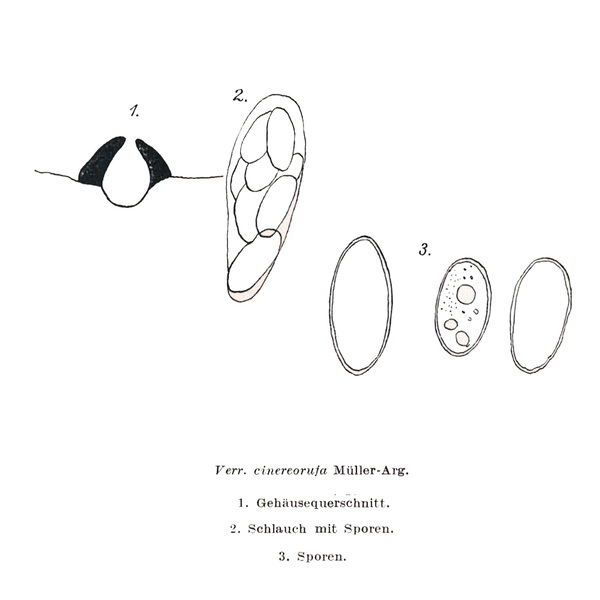Verrucaria cinereorufa Schaer.
Lich. Helv. Spicil., 7: 338, 1836.
Synonyms: Verrucaria clauzadei de Lesd. ?
Distribution: N - Frl (Breuss 2008), Lomb, Piem (Morisi 2005), Lig.
Description: Thallus crustose, endosubstratic or thinly episubstratic, not subgelatinous when wet, brownish grey to brown, continuous to finely rimose near the perithecia, dull, abruptly delimited, sometimes with a thin black prothallus. Cortex poorly developed; algal layer thin. Perithecia black, numerous, 40-60(-100)/cm², half to ¾ immersed in the rock and leaving shallow to deep pits when they fall off, the upper part hemispherically projecting, c. 0.35-0.45 mm across, with a convex to slightly flattened ostiolar region. Involucrellum reaching the upper half of the perithecium and there c. 150 μm thick; exciple subglobose, 0.3-0.4 mm across, the wall dark brown to black; hamathecium of branched and anastomosing periphyses and periphysoids measuring 80-100 x (1.5-)3-4 μm, interascal filaments absent; hymenial gel hemiamyloid, I+ red (I+ blue at very low concentrations of I), K/I+ blue. Asci 8-spored, clavate, I-, fissitunicate, the wall thickened above, with an ocular chamber, dehiscent by extrusion of an endotunica to form a delicate rostrum, Verrucaria-type. Ascospores 1-celled, hyaline, ellipsoid, (28-)30-40(-41) x (13-)14-16(-18) μm. Photobiont chlorococcoid, the cells not arranged in vertical columns. Spot tests: K-, C-, KC-, P-, UV-. Chemistry: without lichen substances.Note: a poorly known species of periodically humid surfaces of calcareous or dolomitic rocks, also reported from the western Pyrenees and from several sites of Western and Central Europe.
Growth form: Crustose
Substrata: rocks
Photobiont: green algae other than Trentepohlia
Reproductive strategy: mainly sexual
Most common in areas with a humid-warm climate (e.g. most of Tyrrenian Italy)
Poorly known taxon in need of further study
Commonnes-rarity: (info)
Alpine belt: absent
Subalpine belt: extremely rare
Oromediterranean belt: absent
Montane belt: rare
Submediterranean belt: very rare
Padanian area: absent
Humid submediterranean belt: absent
Humid mediterranean belt: absent
Dry mediterranean belt: absent

Predictive model
Herbarium samples
Growth form: Crustose
Substrata: rocks
Photobiont: green algae other than Trentepohlia
Reproductive strategy: mainly sexual
Most common in areas with a humid-warm climate (e.g. most of Tyrrenian Italy)
Poorly known taxon in need of further study
Commonnes-rarity: (info)
Alpine belt: absent
Subalpine belt: extremely rare
Oromediterranean belt: absent
Montane belt: rare
Submediterranean belt: very rare
Padanian area: absent
Humid submediterranean belt: absent
Humid mediterranean belt: absent
Dry mediterranean belt: absent

Predictive model
| Herbarium samples |
 INDEX FUNGORUM
INDEX FUNGORUM
 GBIF
GBIF
 DOLICHENS
DOLICHENS


